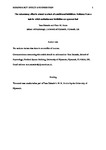The redundancy effect is related to a lack of conditioned inhibition: Evidence from a task in which excitation and inhibition are symmetrical
| dc.contributor.author | Zaksaite, Gintare | |
| dc.contributor.author | Jones, Peter | |
| dc.date.accessioned | 2019-08-14T13:22:20Z | |
| dc.date.issued | 2019-09-09 | |
| dc.identifier.issn | 1747-0218 | |
| dc.identifier.issn | 1747-0226 | |
| dc.identifier.uri | http://hdl.handle.net/10026.1/14793 | |
| dc.description.abstract |
<jats:p> Rescorla and Wagner’s model of learning describes excitation and inhibition as symmetrical opposites. However, tasks used in human causal learning experiments, such as the allergist task, generally involve learning about cues leading to the presence or absence of the outcome, which may not reflect this assumption. This is important when considering learning effects which provide a challenge to this model, such as the redundancy effect. The redundancy effect describes higher causal ratings for the blocked cue X than for the uncorrelated cue Y in the design A+/AX+/BY+/CY–, the opposite pattern to that predicted by the Rescorla–Wagner model, which predicts higher associative strength for Y than for X. Crucially, this prediction depends on cue C gaining some inhibitory associative strength. In this article, we used a task in which cues could have independent inhibitory effects on the outcome, to investigate whether a lack of inhibition was related to the redundancy effect. In Experiment 1, inhibition for C was not detected in the allergist task, supporting this possibility. Three further experiments using the alternative task showed that a lack of inhibition was related to the redundancy effect: the redundancy effect was smaller when C was rated as inhibitory. Individual variation in the strength of inhibition for C also determined the size of the redundancy effect. Given that weak inhibition was detected in the alternative scenario but not in the allergist task, we recommend carefully choosing the type of task used to investigate associative learning phenomena, as it may influence results. </jats:p> | |
| dc.format.extent | 260-278 | |
| dc.format.medium | Print-Electronic | |
| dc.language | en | |
| dc.language.iso | en | |
| dc.publisher | SAGE Publications | |
| dc.subject | Inhibition | |
| dc.subject | allergist task | |
| dc.subject | redundancy effect | |
| dc.subject | human causal learning | |
| dc.subject | Rescorla-Wagner (1972) model | |
| dc.title | The redundancy effect is related to a lack of conditioned inhibition: Evidence from a task in which excitation and inhibition are symmetrical | |
| dc.type | journal-article | |
| dc.type | Journal Article | |
| plymouth.author-url | https://www.webofscience.com/api/gateway?GWVersion=2&SrcApp=PARTNER_APP&SrcAuth=LinksAMR&KeyUT=WOS:000508947800009&DestLinkType=FullRecord&DestApp=ALL_WOS&UsrCustomerID=11bb513d99f797142bcfeffcc58ea008 | |
| plymouth.issue | 2 | |
| plymouth.volume | 73 | |
| plymouth.publication-status | Published | |
| plymouth.journal | Quarterly Journal of Experimental Psychology | |
| dc.identifier.doi | 10.1177/1747021819878430 | |
| plymouth.organisational-group | /Plymouth | |
| plymouth.organisational-group | /Plymouth/Faculty of Health | |
| plymouth.organisational-group | /Plymouth/Faculty of Health/School of Psychology | |
| plymouth.organisational-group | /Plymouth/REF 2021 Researchers by UoA | |
| plymouth.organisational-group | /Plymouth/REF 2021 Researchers by UoA/UoA04 Psychology, Psychiatry and Neuroscience | |
| plymouth.organisational-group | /Plymouth/Users by role | |
| plymouth.organisational-group | /Plymouth/Users by role/Academics | |
| dc.publisher.place | England | |
| dcterms.dateAccepted | 2019-08-07 | |
| dc.rights.embargodate | 2019-9-20 | |
| dc.identifier.eissn | 1747-0226 | |
| dc.rights.embargoperiod | Not known | |
| rioxxterms.version | Accepted Manuscript | |
| rioxxterms.versionofrecord | 10.1177/1747021819878430 | |
| rioxxterms.licenseref.uri | http://www.rioxx.net/licenses/all-rights-reserved | |
| rioxxterms.licenseref.startdate | 2019-09-09 | |
| rioxxterms.type | Journal Article/Review |


